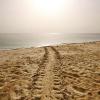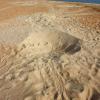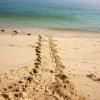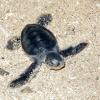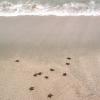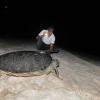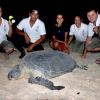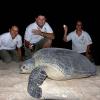Endangered Sea-turtles nesting on Kuwait Islands
Endangered Sea Turtles choose Kuwait Islands to make a unique nesting area in the Gulf.
By Nancy Papathanasopoulou
They are silent and discreet. Unless looked for, they may easily be missed, despite their sheer size of up to 1,60m from head to tail and their weight of up to 250 kg. Yet they emerge from their natural element, the sea, and dig deep, sometimes for two hours. Laying their eggs has been their secret for survival on earth for more than a hundred million years. Their eggs must be laid, from May to September, in a carefully groomed egg chamber, usually about one meter under the surface of the sand, where they will have ideal conditions to develop and hatch, almost two months after they are laid there by their mother. In Qaru Island especially, Green turtles do much more than that. Presumably because of the extremely high temperatures, nesting mothers dig even deeper, reaching almost a meter and a half, so their offspring can develop normally away from the scorching heat. By the time the mothers are finished nesting, they are so exhausted that they can barely reach the water again. And because of the mother's sacrifice, baby turtles hatch, come out of their nests by the hundreds to join the difficult race for survival that they have been joining for so many millenaries before today. In natural conditions, only one in a thousand will become an adult. The stakes are high for sea turtles, and today they are seriously endangered worldwide.
Kuwait hosts at least two species of nesting turtles on its offshore islands Qaru and Umm Al-Maradim. Green turtles (Chelonia mydas) and Hawksbill turtles (Eretmochelys imbricata) nest there in different times of the year. Possible presence of the Loggerhead (Caretta caretta) and Leatherback (Dermochelys coriacea) turtle is being researched. Environmental laws in Kuwait, as in many other countries, prohibit any sort of disturbance of these animals or their hatchlings.
But why is it important to protect sea turtles? Why are nations worldwide creating strict texts of conventions and legislations in a common effort beyond borders to ensure their survival? The answers are not difficult. Many decades of scientific research and constant monitoring have proven that:
- Sea turtles are necessary for the survival of coral reefs worldwide. Without coral reefs, the degradation of life in the oceans would be imminent. Fisheries worldwide would be gravely affected.
- Sea turtles are responsible for the migrations of several hundred species of organisms, which attach themselves on the animal and “hitch a ride”. Without this means of transport, propagation and ecological processes of these organisms would stop, and this would have an impact on the ocean’s health and prosperity.
- Sea turtles have existed for over a hundred million years, are an animal species that has survived all dramatic changes on earth and has an important role to fulfill, like all major species on the planet. Sea turtles have seen and lived with the dinosaurs. They have been great survivors of what eliminated the dinosaurs. Their extinction would seriously erode biodiversity on earth.
- As with every animal species, protecting it during its whole cycle of life is essential. For turtles, feeding, mating and nesting grounds should be protected from degradation and elimination, and migratory routes should be studied in order to achieve some level of protection there as well.
The Kuwait Turtle Conservation Project (www.kuwaitturtles.com) was launched in June 2008 and currently going through its second year. It is a common 3-year effort of TOTAL Foundation, TOTAL Kuwait, The Voluntary Work Center Kuwait and The Scientific Center of Kuwait to enhance knowledge of endangered sea turtles in the country, study their populations on islands Qaru and Umm Al-Maradim, study the state of the marine and coastal areas the turtles live in and conduct environmental information and education to as many groups of stakeholders as possible.
Both Islands are excellent refuges for sea turtles, or they would be, if left to the turtles during nesting and hatching season. Disturbances such as noise, light, fire, garbage and human voices during the night deter females from coming to shore to nest, parasols in the sand are likely to destroy nests and walking on the nests repeatedly compresses the sand above and may suffocate the 100 eggs that are lain in there. Will future generations of Kuwaitis still boast the existance of sea turtles in their country or will it soon be all over?
To the summer island visitor: Be aware that your visit needs to be discreet and careful. And when your excursion ends, leave only footprints or bubbles behind...

